World Roundup
March/April 2014


-
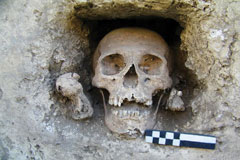 MEXICO: At the mid-14th-century site of Tehuacán in the state of Puebla, archaeologists have identified a shrine they believe was dedicated to Mictlantecuhtli, Aztec god of the dead. Two niches there each contained a skull and four femurs. Atop the temple were two clay heads believed to represent Mictlantecuhtli, along with hundreds of pieces of human remains, suggesting sacrifices. It is believed the site was built by the Popolocas people, who were conquered by the Aztecs in 1456. —Samir S. Patel
MEXICO: At the mid-14th-century site of Tehuacán in the state of Puebla, archaeologists have identified a shrine they believe was dedicated to Mictlantecuhtli, Aztec god of the dead. Two niches there each contained a skull and four femurs. Atop the temple were two clay heads believed to represent Mictlantecuhtli, along with hundreds of pieces of human remains, suggesting sacrifices. It is believed the site was built by the Popolocas people, who were conquered by the Aztecs in 1456. —Samir S. Patel -
 BOLIVIA: According to legend, Lake Titicaca is home to Inca treasure and submerged cities. Underwater archaeologists have recently found thousands of objects around the “Island of the Sun,” most of which date to the pre-Inca Tiwanaku period (7th–11th centuries). Among the finds are incense containers, animal figurines, and 31 pieces of gold leaf in the shape of llamas and pumas. Rather than Inca treasure, the finds are evidence of the ways the Inca co-opted old sacred sites—the objects were likely ritual offerings—to consolidate power. —Samir S. Patel
BOLIVIA: According to legend, Lake Titicaca is home to Inca treasure and submerged cities. Underwater archaeologists have recently found thousands of objects around the “Island of the Sun,” most of which date to the pre-Inca Tiwanaku period (7th–11th centuries). Among the finds are incense containers, animal figurines, and 31 pieces of gold leaf in the shape of llamas and pumas. Rather than Inca treasure, the finds are evidence of the ways the Inca co-opted old sacred sites—the objects were likely ritual offerings—to consolidate power. —Samir S. Patel -
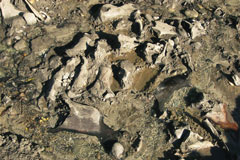 URUGUAY: Could Lestodon, a 15-foot-tall ground sloth, have been on the menu of early humans? In a bone deposit, paleontologists found fragments of 19 individuals, and 40 of these pieces of bone appear to have cut marks, suggesting humans processed them. But the deposit dates to nearly 30,000 years ago, thousands of years before humans are thought to have arrived in the Americas. The researchers are confident in their findings, which are likely to be controversial. It’s possible that the marks were the result of some natural process. —Samir S. Patel
URUGUAY: Could Lestodon, a 15-foot-tall ground sloth, have been on the menu of early humans? In a bone deposit, paleontologists found fragments of 19 individuals, and 40 of these pieces of bone appear to have cut marks, suggesting humans processed them. But the deposit dates to nearly 30,000 years ago, thousands of years before humans are thought to have arrived in the Americas. The researchers are confident in their findings, which are likely to be controversial. It’s possible that the marks were the result of some natural process. —Samir S. Patel -
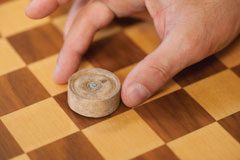 ENGLAND: Excavations at an Anglo-Saxon site have turned up a single piece from a high-quality gaming set dating to the 7th century. Made from a hollow cylinder of bone with carved end caps and a copper alloy pin holding it together, the token, found in a royal complex that was home to both game-playing and feasting. It was likely used in an unknown game akin to backgammon or checkers. Its owner might have been disappointed to have lost a piece from such a fine set, or might have cast it away in anger after a biting loss. — Samir S. Patel
ENGLAND: Excavations at an Anglo-Saxon site have turned up a single piece from a high-quality gaming set dating to the 7th century. Made from a hollow cylinder of bone with carved end caps and a copper alloy pin holding it together, the token, found in a royal complex that was home to both game-playing and feasting. It was likely used in an unknown game akin to backgammon or checkers. Its owner might have been disappointed to have lost a piece from such a fine set, or might have cast it away in anger after a biting loss. — Samir S. Patel -
 POLAND: A cemetery belonging to people of the Lusatian culture, from the late Bronze Age and early Iron Age, has turned up around a thousand ceramic vessels. The Lusatians, a culture of cereal farmers and herdspeople, cremated their dead and buried the bones in urns alongside grave goods such as richly ornamented vessels, jewelry, and tools. Among the 151 graves excavated in this cemetery are a number of children’s graves, which include miniature clay vessels and even clay rattles. —Samir S. Patel
POLAND: A cemetery belonging to people of the Lusatian culture, from the late Bronze Age and early Iron Age, has turned up around a thousand ceramic vessels. The Lusatians, a culture of cereal farmers and herdspeople, cremated their dead and buried the bones in urns alongside grave goods such as richly ornamented vessels, jewelry, and tools. Among the 151 graves excavated in this cemetery are a number of children’s graves, which include miniature clay vessels and even clay rattles. —Samir S. Patel -
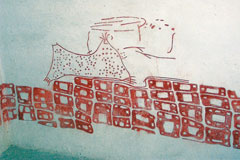 TURKEY: A painting at the Neolithic city of Çatalhöyük may depict the city beneath two peaks, one of which appears to be erupting. While another theory posits it is a geometric pattern topped by a leopard skin, the painting could represent the Hasan Dag volcano 80 miles away, making it the oldest known depiction of an eruption. A new dating technique for volcanic rocks confirms that Hasan Dag did indeed erupt about 9,000 years ago, around when the painting was made. Volcanologists believe the eruption was mild—a bit of a lava “burp.” —Samir S. Patel
TURKEY: A painting at the Neolithic city of Çatalhöyük may depict the city beneath two peaks, one of which appears to be erupting. While another theory posits it is a geometric pattern topped by a leopard skin, the painting could represent the Hasan Dag volcano 80 miles away, making it the oldest known depiction of an eruption. A new dating technique for volcanic rocks confirms that Hasan Dag did indeed erupt about 9,000 years ago, around when the painting was made. Volcanologists believe the eruption was mild—a bit of a lava “burp.” —Samir S. Patel -
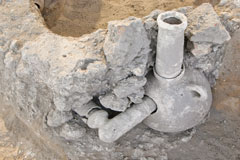 ISRAEL: Construction of a highway bridge in Ramla has revealed a building belonging to a wealthy family, with a mosaic fountain dating to the Fatamid period in the late 10th and early 11th centuries. The fountain, which includes a system of terracotta pipes and connectors made of old jars, is the first of its kind found outside the wealthy district of Old Ramla and the first found with its plumbing intact. —Samir S. Patel
ISRAEL: Construction of a highway bridge in Ramla has revealed a building belonging to a wealthy family, with a mosaic fountain dating to the Fatamid period in the late 10th and early 11th centuries. The fountain, which includes a system of terracotta pipes and connectors made of old jars, is the first of its kind found outside the wealthy district of Old Ramla and the first found with its plumbing intact. —Samir S. Patel -
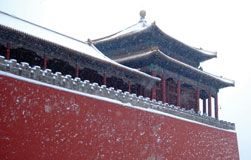 CHINA: Countless words have been written about how the Egyptians moved the large stone blocks of the pyramids into place, but less attention has been paid to how the Chinese moved the massive blocks of the Forbidden City in Beijing in the 15th and 16th centuries. A new analysis of historical records and mechanical tests shows that stone could have been moved 40 miles, from quarry to the Forbidden City, on ice roads lubricated with water. Just 46 men would have been needed to move a 123-ton block. —Samir S. Patel
CHINA: Countless words have been written about how the Egyptians moved the large stone blocks of the pyramids into place, but less attention has been paid to how the Chinese moved the massive blocks of the Forbidden City in Beijing in the 15th and 16th centuries. A new analysis of historical records and mechanical tests shows that stone could have been moved 40 miles, from quarry to the Forbidden City, on ice roads lubricated with water. Just 46 men would have been needed to move a 123-ton block. —Samir S. Patel -
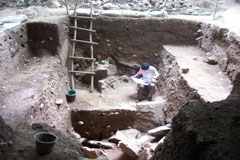 PHILIPPINES: Skeletal remains dating to more than 9,000 years ago tell of a previously undocumented burial ritual involving disarticulation, defleshing, crushing, and then burning. The fragmentary bones bearing signs of this complex activity were buried in a shallow pit outside the mouth of Ille Cave. Five other sets of remains found there bear similar marks. Clearly, it was an elaborate process, but much is still unknown about the culture that engaged in it. —Samir S. Patel
PHILIPPINES: Skeletal remains dating to more than 9,000 years ago tell of a previously undocumented burial ritual involving disarticulation, defleshing, crushing, and then burning. The fragmentary bones bearing signs of this complex activity were buried in a shallow pit outside the mouth of Ille Cave. Five other sets of remains found there bear similar marks. Clearly, it was an elaborate process, but much is still unknown about the culture that engaged in it. —Samir S. Patel -
 PAPUA NEW GUINEA: In late 2010, at a construction site on New Britain Island, archaeologists uncovered a cache of sophisticated obsidian tools dating to between 3,000 and 6,000 years ago. Upon analysis, scientists found that at least five of the tools were thin, fragile, and unused—suggesting a ritual or decorative purpose—and appear to have a distinctly phallic shape. There are few archaeological sites from this period in Papuan history, and the discovery suggests an early, previously unrecognized trade in ritual objects before the emergence of the Lapita culture across the South Pacific. —Samir S. Patel
PAPUA NEW GUINEA: In late 2010, at a construction site on New Britain Island, archaeologists uncovered a cache of sophisticated obsidian tools dating to between 3,000 and 6,000 years ago. Upon analysis, scientists found that at least five of the tools were thin, fragile, and unused—suggesting a ritual or decorative purpose—and appear to have a distinctly phallic shape. There are few archaeological sites from this period in Papuan history, and the discovery suggests an early, previously unrecognized trade in ritual objects before the emergence of the Lapita culture across the South Pacific. —Samir S. Patel
Advertisement
IN THIS ISSUE
Features
Saving the Villa of the Mysteries
All Hands on Deck
Messengers to the Gods
Letter From Borneo
From the Trenches
Our Tangled Ancestry
Off the Grid
Viking Finery
Scuttled but Not Forgotten
Game of Stones
How to Pray to a Storm God
Triangulating Buddha's Birth
Mesopotamian Accounts Receivable
Barbarian Body Modification
Did Neanderthals Bury Their Dead?
Florida History Springs Forth
Turtle Power
Battle of the Proxies
World Roundup
Aztec god of the dead, gold in Lake Titicaca, Anglo-Saxon gaming piece, and building the Forbidden City
Artifact
The importance of music in Peru
Advertisement

Recent Issues
-
 May/June 2024
May/June 2024
-
 March/April 2024
March/April 2024
-
 January/February 2024
January/February 2024
-
 November/December 2023
November/December 2023
-
 September/October 2023
September/October 2023
-
 July/August 2023
July/August 2023
-
 May/June 2023
May/June 2023
-
 March/April 2023
March/April 2023
-
 January/February 2023
January/February 2023
-
 November/December 2022
November/December 2022
-
 September/October 2022
September/October 2022
-
 July/August 2022
July/August 2022
-
 May/June 2022
May/June 2022
-
 March/April 2022
March/April 2022
-
 January/February 2022
January/February 2022
-
 November/December 2021
November/December 2021
-
 September/October 2021
September/October 2021
-
 July/August 2021
July/August 2021
-
 May/June 2021
May/June 2021
-
 March/April 2021
March/April 2021
-
 January/February 2021
January/February 2021
-
 November/December 2020
November/December 2020
-
 September/October 2020
September/October 2020
-
 July/August 2020
July/August 2020
-
 May/June 2020
May/June 2020
-
 March/April 2020
March/April 2020
-
 January/February 2020
January/February 2020
-
 November/December 2019
November/December 2019
-
 September/October 2019
September/October 2019
-
 July/August 2019
July/August 2019
-
 May/June 2019
May/June 2019
-
 March/April 2019
March/April 2019
-
 January/February 2019
January/February 2019
-
 November/December 2018
November/December 2018
-
 September/October 2018
September/October 2018
-
 July/August 2018
July/August 2018
-
 May/June 2018
May/June 2018
-
 March/April 2018
March/April 2018
-
 January/February 2018
January/February 2018
-
 November/December 2017
November/December 2017
-
 September/October 2017
September/October 2017
-
 July/August 2017
July/August 2017
-
 May/June 2017
May/June 2017
-
 March/April 2017
March/April 2017
-
 January/February 2017
January/February 2017
-
 November/December 2016
November/December 2016
-
 September/October 2016
September/October 2016
-
 July/August 2016
July/August 2016
-
 May/June 2016
May/June 2016
-
 March/April 2016
March/April 2016
-
 January/February 2016
January/February 2016
-
 November/December 2015
November/December 2015
-
 September/October 2015
September/October 2015
-
 July/August 2015
July/August 2015
-
 May/June 2015
May/June 2015
-
 March/April 2015
March/April 2015
-
 January/February 2015
January/February 2015
-
 November/December 2014
November/December 2014
-
 September/October 2014
September/October 2014
-
 July/August 2014
July/August 2014
-
 May/June 2014
May/June 2014
-
 March/April 2014
March/April 2014
-
 January/February 2014
January/February 2014
-
 November/December 2013
November/December 2013
-
 September/October 2013
September/October 2013
-
 July/August 2013
July/August 2013
-
 May/June 2013
May/June 2013
-
 March/April 2013
March/April 2013
-
 January/February 2013
January/February 2013
-
 November/December 2012
November/December 2012
-
 Sep/Oct 2012
Sep/Oct 2012
-
 September/October 2012
September/October 2012
-
 July/August 2012
July/August 2012
-
 May/June 2012
May/June 2012
-
 March/April 2012
March/April 2012
-
 January/February 2012
January/February 2012
-
 November/December 2011
November/December 2011
-
 September/October 2011
September/October 2011
-
 July/August 2011
July/August 2011
-
 May/June 2011
May/June 2011
-
 March/April 2011
March/April 2011
-
 January/February 2011
January/February 2011
Advertisement






